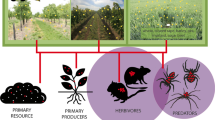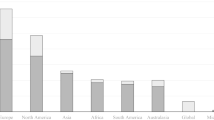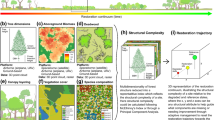Abstract
Site-specific weed management (SSWM) can provide significant herbicide savings but requires the reliable detection of weed populations. In this work, the effect of sample size on sampling precision was studied in four sub-field areas of winter cereals infested with Galium aparine. Plots of 1170 m2, 4212 m2, 2592 m2 and 2880 m2 were marked and the positions of all G. aparine individuals were recorded using a precise navigation system. Mapping cells of 3 m × 3 m were arranged over experimental data and then various sampling intensities of G. aparine populations were simulated. The relative root mean square error, mean absolute percentage error (MAPE), and false negative rate were calculated and plotted against individual sampling intensities. Regressions were fitted to non-linear models. Experimental plots had relatively low mean densities of G. aparine (1.00–2.98 plants m−2) and the spatial distributions of plants were patchy in all cases. The values of all error measures decreased with increasing sampling intensity. On the basis of the fitted model, keeping MAPE below 30% required the sampling of 32.2% of the total area for the low-density population and 13.4% for the highest-density population. The results presented demonstrate that reliable sampling of low-density populations requires a very high sampling intensity and could be helpful in the design of reliable sampling strategies for SSWM.









Similar content being viewed by others
Data availability
Original data sets analysed during this study are included in supplementary information files.
Code availability
Not applicable.
References
Armstrong, J. S., & Collopy, F. (1992). Error measures for generalizing about forecasting methods: Empirical comparisons. International Journal of Forecasting, 8, 69–80.
Backes, M., Schumacher, D., & Plümer, L. (2005). The sampling problem in weed control—Are currently applied sampling strategies adequate for site-specific weed control? In: J. V. Stafford (Ed.), Precision Agriculture ‘05, Proceedings of the 5th European Conference on Precision Agriculture (pp. 155–161). Wageningen, The Netherlands: Wageningen Academic Publishers.
Baddeley, A., & Turner, R. (2005). spatstat: An R package for analyzing spatial point patterns. Journal of Statistical Software, 12(6), 1–42.
Barroso, J., Fernandez-Quintanilla, C., Maxwell, B. D., & Rew, L. J. (2004). Simulating the effects of weed spatial pattern and resolution of mapping and spraying on economics of site-specific management. Weed Research, 44, 460–468.
Baty, F., Ritz, C., Charles, S., Brutsche, M., Flandrois, J. P., & Delignette-Muller, M. L. (2015). A toolbox for nonlinear regression in R: The package nlstools. Journal of Statistical Software, 66(5), 1–21.
Berge, T. W., Cederkvist, H. R., Aastveit, A. H., & Fykse, H. (2008). Simulating the effects of mapping and spraying resolution and threshold level on accuracy of patch spraying decisions and herbicide use based on mapped weed data. Acta Agriculturae Scandinavica Section B-Soil and Plant Science, 58(3), 216–229.
Berge, T. W., Fykse, H., & Aastveit, A. H. (2007). Patch spraying of weeds in spring cereals: Simulated influences of threshold level and spraying resolution on spraying errors and potential herbicide reduction. Acta Agriculturae Scandinavica Section B-Soil and Plant Science, 57, 212–221.
Berge, T. W., Goldberg, S., Kaspersen, K., & Netland, J. (2012). Towards machine vision based site-specific weed management in cereals. Computers and Electronics in Agriculture, 81, 79–86.
Bliss, C. I., & Fisher, R. A. (1953). Fitting the negative binomial distribution to biological data. Biometrics, 9, 176–200.
Boero, G., Smith, J., & Wallis, K. F. (2005). The sensitivity of Chi-squared goodness-of-fit tests to the partitioning of data. Econometric Reviews, 23, 341–370.
Chai, T., & Draxler, R. R. (2014). Root mean square error (RMSE) or mean absolute error (MAE)?—Arguments against avoiding RMSE in the literature. Geoscientific Model Development, 7, 1247–1250.
Cho, S. I., Lee, D. S., & Jeong, J. Y. (2002). Weed–plant discrimination by machine vision and artificial neural network. Biosystems Engineering, 83, 275–280.
Colbach, N., Dessaint, F., & Forcella, F. (2000). Evaluating field-scale sampling methods for the estimation of mean plant densities of weeds. Weed Research, 40, 411–430.
Cousens, R. D., Brown, R. W., McBratney, A. B., & Moerkerk, M. (2002). Sampling strategy is important for producing weed maps: A case study using kriging. Weed Science, 50, 542–546.
Delignette-Muller, M. L., & Dutang, C. (2015). fitdistrplus: An R package for fitting distributions. Journal of Statistical Software, 64(4), 1–34.
Dille, J. A., Milner, M., Groeteke, J. J., Mortensen, D. A., & Williams, M. M. (2003). How good is your weed map? A comparison of spatial interpolators. Weed Science, 51, 44–55.
Dyrmann, M., Jørgensen, R. N., & Midtiby, H. S. (2017). RoboWeedSupport—Detection of weed locations in leaf occluded cereal crops using a fully convolutional neural network. In J. A. Taylor, D. Cammarano, A. Prashar, A. Hamilton (Eds.), Proceedings of the 11th European Conference on Precision Agriculture. Advances in Animal Biosciences (Vol. 8, pp. 842–847).
Felton, W. L., & McCloy, K. R. (1992). Spot spraying. Agricultural Engineering, 73, 9–12.
Ferreira, A. S., Freitas, D. M., da Silva, G. G., Pistorib, H., & Folhes, M. T. (2017). Weed detection in soybean crops using ConvNets. Computers and Electronics in Agriculture, 143, 314–324.
Gerhards, R., & Oebel, H. (2006). Practical experiences with a system for site-specific weed control in arable crops using real-time image analysis and GPS-controlled patch spraying. Weed Research, 46, 185–193.
Gerowitt, B., & Heitefuss, R. (1990). Weed economic thresholds in cereals in the Federal Republic of Germany. Crop Protection, 9, 323–331.
Gold, H. J., Bay, J., & Wilkerson, G. G. (1996). Scouting for weeds, based on the negative binomial distribution. Weed Science, 44, 504–510.
Grothendieck, G. (2013). nls2: Non-linear regression with brute force. R package version 0.2. https://CRAN.R-project.org/package=nls2. Last accessed 15 August 2021
Hamouz, P., Hamouzová, K., Holec, J., & Tyšer, L. (2014a). Impact of site-specific weed management in winter crops on weed populations. Plant, Soil and Environment, 60, 518–524.
Hamouz, P., Hamouzová, K., Tyšer, L., & Holec, J. (2014b). Effect of site-specific weed management in winter crops on yield and weed populations. Plant, Soil and Environment, 60, 27–35.
Heijting, S., Van Der Werf, W., & Kropff, M. J. (2009). Seed dispersal by forage harvester and rigid-tine cultivator in maize. Weed Research, 49, 153–163.
Heijting, S., Van Der Werf, W., Kruijer, W., & Stein, A. (2007). Testing the spatial significance of weed patterns in arable land using Mead’s test. Weed Research, 47, 396–405.
Lancashire, P. D., Bleiholder, H., Langelüddecke, P., Stauss, R., Van Den Boom, T., Weber, E., et al. (1991). A uniform decimal code for growth stages of crops and weeds. Annals of Applied Biology, 119, 561–601.
Laursen, M. S., Jørgensen, R. N., Midtiby, H. S., Jensen, K., Christiansen, M. P., Giselsson, T., et al. (2016). Dicotyledon weed quantification algorithm for selective herbicide application in maize crops. Sensors, 16, 1848.
Lee, W. S., Slaughter, D. C., & Giles, D. K. (1999). Robotic weed control system for tomatoes. Precision Agriculture, 1, 95–113.
López-Granados, F., Jurado-Expósito, M., Peña-Barragán, J. M., & García-Torres, L. (2006). Using remote sensing for identification of late-season grass weed patches in wheat. Weed Science, 54, 346–353.
Marshall, E. J. P. (1988). Field-scale estimates of grass weed populations in arable land. Weed Research, 28, 191–198.
Marshall, E. J. P., & Brain, P. (1999). The horizontal movement of seeds in arable soil by different soil cultivation methods. Journal of Applied Ecology, 36, 443–454.
McCanny, S. J., & Cavers, P. B. (1988). Spread of proso millet (Panicum miliaceum L.) in Ontario, Canada. II. Dispersal by combines. Weed Research, 28, 67–72.
Meroni, M., Busetto, L., Colombo, R., Guanter, L., Moreno, J., & Verhoef, W. (2010). Performance of spectral fitting methods for vegetation fluorescence quantification. Remote Sensing of Environment, 114, 363–374.
Motulsky, H., & Christopoulos, A. (2004). Fitting models to biological data using linear and nonlinear regression: A practical guide to curve fitting. Oxford University Press.
Peteinatos, G. G., Reichel, P., Karouta, J., Andujar, D., & Gerhards, R. (2020). Weed identification in maize, sunflower, and potatoes with the aid of Convolutional Neural Networks. Remote Sensing, 12, 4185.
Rasmussen, J., Azim, S., Nielsen, J., Mikkelsen, B. F., Hørfarter, R., & Christensen, S. (2020). A new method to estimate the spatial correlation between planned and actual patch spraying of herbicides. Precision Agriculture, 21, 713–728.
Rew, L. J., Alston, C. L., Harden, S., & Felton, W. L. (2000). Counts versus categories: Choosing the more appropriate weed scoring method. Australian Journal of Experimental Agriculture, 40, 1121–1129.
Rew, L. J., & Cussans, G. W. (1997). Horizontal movement of seeds following tine and plough cultivation: Implications for spatial dynamics of weed infestations. Weed Research, 37, 247–256.
Rew, L. J., Cussans, G. W., Mugglestone, M. A., & Miller, P. C. H. (1996). A technique for mapping the spatial distribution of Elymus repens, with estimates of the potential reduction in herbicide usage from patch spraying. Weed Research, 36, 283–292.
Rew, L. J., Miller, P. C. H., & Paice, M. E. R. (1997). The importance of patch mapping resolution for sprayer control. Aspects of Applied Biology, 48, 49–56.
Ritz, C., & Streibig, J. C. (2008). Nonlinear regression with R. Springer Science+Business Media, LLC.
Schuster, I., Nordmeyer, H., & Rath, T. (2007). Comparison of vision-based and manual weed mapping in sugar beet. Biosystems Engineering, 98, 17–25.
Teimouri, N., Dyrmann, M., Nielsen, P. R., Mathiassen, S. K., Somerville, G. J., & Jørgensen, R. N. (2018). Weed growth stage estimator using deep convolutional neural networks. Sensors, 18, 1580. https://doi.org/10.3390/s18051580
Torres-Sánchez, J., López-Granados, F., De Castro, A. I., & Peña-Barragán, J. M. (2013). Configuration and specifications of an unmanned aerial vehicle (UAV) for early site-specific weed management. PLoS One, 8, 0058210.
Trimble. (2003). 5700/5800 GPS Receiver User Guide, Version 2.00, Sunnyvale, CA, USA.
Wallinga, J., Groeneveld, R. M. W., & Lotz, L. A. P. (1998). Measures that describe weed spatial patterns at different levels of resolution and their applications for patch spraying of weeds. Weed Research, 38, 351–359.
Wiles, L. J. (2005). Sampling to make maps for site-specific weed management. Weed Science, 53, 228–235.
Wiles, L. J., Oliver, G. W., York, A. C., Gold, H. J., & Wilkerson, G. G. (1992). Spatial distribution of broadleaf weeds in North Carolina soybean (Glycine max) fields. Weed Science, 40, 554–557.
Acknowledgements
This work was supported by the Institutional Support Program for Long Term Conceptual Development of Research Institutions provided by Ministry of Education, Youth and Sports of the Czech Republic. We would like to give special thanks to Theresa Reinhardt Piskackova, Ph.D. for English proofreading.
Funding
This work was supported by the Institutional Support Program for Long Term Conceptual Development of Research Institutions provided by Ministry of Education, Youth and Sports of the Czech Republic.
Author information
Authors and Affiliations
Contributions
Both authors contributed to the study conception and design, material preparation, data collection. Analysis were performed by PH. The first draft of the manuscript was written by PH and both authors commented on previous versions of the manuscript. Both authors read and approved the final manuscript.
Corresponding author
Ethics declarations
Ethical approval
Not applicable.
Consent to participate
Not applicable.
Consent for publication
Not applicable.
Additional information
Publisher's Note
Springer Nature remains neutral with regard to jurisdictional claims in published maps and institutional affiliations.
Supplementary Information
Below is the link to the electronic supplementary material.
Rights and permissions
About this article
Cite this article
Hamouz, P., Hamouzová, K. Analysis of sampling precision in low-density weed populations. Precision Agric 23, 603–621 (2022). https://doi.org/10.1007/s11119-021-09851-6
Accepted:
Published:
Issue Date:
DOI: https://doi.org/10.1007/s11119-021-09851-6




